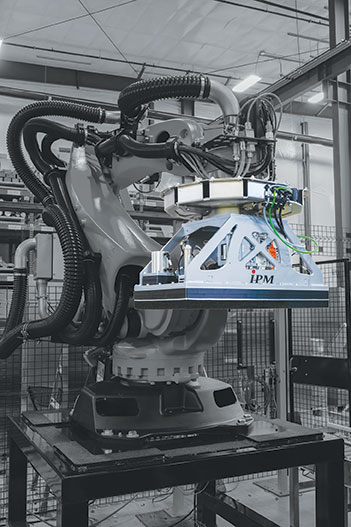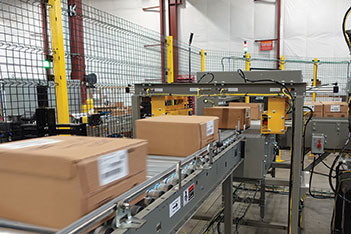 |
|||


|
 |


|
|

IPM secondary packaging solutions increase uptime, strengthen profit
 Photo courtesy of Integrated Packaging Machinery Photo courtesy of Integrated Packaging Machinery |
| ACCUTURRET — Integrated Packaging Machinery’s AccuTURRET cable management assembly increases the agility of the end-of-arm tool (EOAT) without increasing the demand on the electrical, air, ethernet and related control infrastructure running through the robot’s EOAT wrist. |
 Photo courtesy of Integrated Packaging Machinery Photo courtesy of Integrated Packaging Machinery |
| INFEED AND BUMP TURN — As 40-pound cases of cheese exit the case packer and approach the robotic palletizer, they pass through a unique bump-turn unit operation that precisely orients each case according to the pre-programmed pallet pattern. |
ROCKFORD, Mich. — Integrated Packaging Machinery (IPM) designs, specifies, integrates, automates and installs food and beverage packaging systems and sub-systems, many of which are new. Many other projects are major upgrades or rebuilds of existing packaging operations, emphasizing automation and control designed to deliver more uptime. This “system-as-a-single-machine” mindset, in direct collaboration with IPM’s customers, advances food-safe, customer-informed and profitable food and beverage packaging operations.
Regardless of project scale, IPM employs a proven OEM-neutral (original equipment manufacturer) design philosophy to deliver a customer-specific, right-sized, right-performance and best-fit packaging system/sub-system solution. This design philosophy integrates a proven approach to scope-specific performance utilizing the best available machine center and unit operation sequence.
Properly engineered line control ensures optimal packaging system uptime that’s consistent, repeatable, uninterrupted, measurable and routinely leveraged.
This rational and repeatable approach to packaging systems engineering is informed and optimized with V-Curve data. Line control engineering, based on V-Curve data, is a mission-critical precursor to achieving prescribed uptime targets dictated by scope freeze and efficiency metrics as well as streamlined automation and control goals upstream and downstream of each machine center, notes Tom Wiersma, marketing and business development, IPM.
“In almost every case, IPM serves as the last mile in protecting our customers’ investment in raw material ingredients, process control performance, packaging materials consumption, utilities infrastructure optimization, brand reputation and shelf-ready consumer preferences,” Wiersma says. “Each of those design imperatives profits from maximum system uptime. Maximum system uptime in turn depends on uninterrupted packaging system runnability.”
Both uptime and runnability depend on properly designed line control, which requires a “system-as-a-single-machine” mindset and a commitment to continuously improve that mindset, he adds.
In practice, IPM’s system-as-a-single-machine model is a collaborative model. It’s also incremental, scalable and adaptable, Wiersma says.
“In that sense, this V-Curve-driven, systems engineering approach can be applied to both new and rebuild projects. In every case — and with every collaborator on the team — arriving at scope freeze as rapidly as possible is the driver,” he says.
A controlled and planned drive for scope freeze might result in trade-offs between budget and performance “must-haves” versus “nice-to-haves,” he adds. But the scope freeze-driven trade-offs that occur are always informed, vetted, collaborative, pragmatic and never arbitrary.
A properly designed line control solution will expertly and repeatedly control, monitor and accommodate unit operations’ anomalies (i.e. micro-stops) and still deliver the best-fit project scope and plant-specific filling, bagging, case packing, conveying, palletizing and other unit operations.
• Increased automation
“More than ever before, automation and line control is, clearly, a mission-critical imperative among our food and beverage processing, packaging, co-manufacturing, private label and contract packaging customers Wiersma notes. “When done well, it reduces staffing needs, reduces waste and significantly improves uptime performance in the last mile. It also has the potential to reduce the cost of utilities infrastructure and to contribute to sustainability initiatives by reducing packaging and food waste.”
With more cheese companies developing unique packaging and multiple SKUs, they also are routinely testing and/or launching different packaging types, sizes and formats, Wiersma notes. For this reason, packaging systems have to be adaptable at handling a variety of package types and case configurations on the same line. This increase in SKUs and responding to retailer “shelf-ready” expectations has placed even more importance on integrating and controlling the precisely best-suited OEM technology, and ultimately systems and sub-systems capable of dealing with multiple packaging materials and shapes.
“Taste options and serving-size options are driving the SKU count higher, so our packaging automation and line control solutions now have to accommodate different package sizes, different package weights and different case types,” he adds.
High-speed, high-volume and complex packaging operations depend on end-of-line palletizing solutions designed not only to contribute to performance — but also to accommodate shelf-ready case- and pallet-level labeling requirements as well as warehouse- and logistics-driven pallet patterns.
In part to accommodate these demands, IPM introduced its patented AccuTURRET end-of-arm tool (EOAT) cable management assembly as the latest addition to its robotic palletizing solutions portfolio. The technology increases the agility of the EOAT without increasing the demand on the electrical, air, ethernet and related control infrastructure running through the robot’s EOAT wrist, Wiersma notes. The AccuTURRET improves the functionality, accuracy, versatility, speed, reach and efficiency of robotic arms in a palletizer application.
“The AccuTURRET has the capability to smoothly rotate the EOAT through a wide arc of operations of a pallet-building operation,” he says, “including handling the offtake of two packaging lines into a single palletizing operation. Every cycle function — from picking and placing the initial slip sheet to lifting full or partial case layers to picking and placing subsequent tier sheets — is accelerated or streamlined.”
He adds that the unique lateral capability of the IPM AccuTURRET technology expands the capability of the robotic arm to perform especially demanding pallet-building operations in space-limited applications. The AccuTURRET not only reduces the complexity and cost of robotic palletizer control systems but also improves robot uptime and lengthens maintenance intervals.
• Proven performance
The success of IPM’s solutions is reflected in several recent projects implemented at dairy plants across the United States. For instance, the company is putting the finishing touches on a secondary packaging system for 40-pound blocks at a major cheese producer.
Wiersma notes one unique aspect of this project is providing the customer with the ability to automatically label one or multiple sides of each 40-pound case with case-specific weight data. This information on every side of the case streamlines the warehousing and logistics processes.
“It’s an innovative use of existing OEM technologies combined, automated and controlled to address customer aspirations detailed in the pre-project scope freeze document,” he says. “In this case, the robotic palletizer, the robotic label applicator and a robotic inter-layer glue application sequence are synchronized and operating simultaneously in the same enclosed space.”
In addition, every “nth” block of cheese is automatically shuttled off the line by a cobot in a pre-palletizer position and sent to the plant lab where it is tested for quality, moisture and more, he adds.
“On the surface, it presents as a complex combination of machines — but in practice it’s a great example of IPM’s ‘system-as-a-single machine’ design philosophy. The result is more uptime, more safety, reduced manual labor and more precise rate, OEE and shift documentation,” he says.
Wiersma notes that IPM designs solutions that are scope specific. The company is OEM-neutral, so it will specify the best combination of technologies to deliver maximum control and uptime per project scope freeze.
“There is a fundamental role for an uptime imperative in conceiving, engineering, integrating, automating and installing OEM-neutral packaging systems in high-volume, typically high-speed and highly regulated plants,” he says. “Cost effectiveness in all parts of the operation will determine the commercial success of any such installation, and routine uptime is a core determining factor of overall effectiveness. Today’s business environment makes that imperative increasingly critical. Downtime is becoming more costly as inflation puts pressure on all operating costs. A more challenging economy makes staying cost-competitive more important than ever.”
IPM approaches each integrated packaging project with its SUREthing (Strategic Uptime Runnability
Engineered) approach to performance deliverables.
“One machine center that goes down or slows down impacts the efficiency of your entire packaging line,” Wiersma says. “It’s clear then that uptime performance of a single machine is not the real issue. The real issue is uptime across the entire line. IPM’s SUREthing performance and uptime scope is centered on seamlessly integrating all of the technology and all of the performance throughout the secondary and tertiary packaging downstream of the filler to meet our customer’s production goals.
“Every new or rebuilt integrated packaging system or sub-system solution we engineer, automate, install and commission is specified for uptime,” he adds. “But that’s just the first step. The second, and real-world step, is to ensure that the specified technology solutions are runnability engineered. We’ll do that on a new line, a sub-system, a packaging line renovation or a rebuilt packaging line.”
CMN
| CMN article search |
|
|
© 2025 Cheese Market News • Quarne Publishing, LLC • Legal Information • Online Privacy Policy • Terms and Conditions
Cheese Market News • Business/Advertising Office: P.O. Box 628254 • Middleton, WI 53562 • 608/831-6002
Cheese Market News • Editorial Office: 5315 Wall Street, Suite 100 • Madison, WI 53718 • 608/288-9090